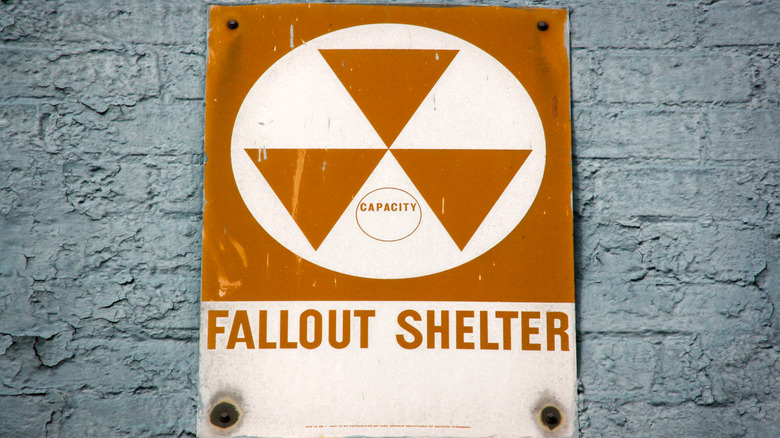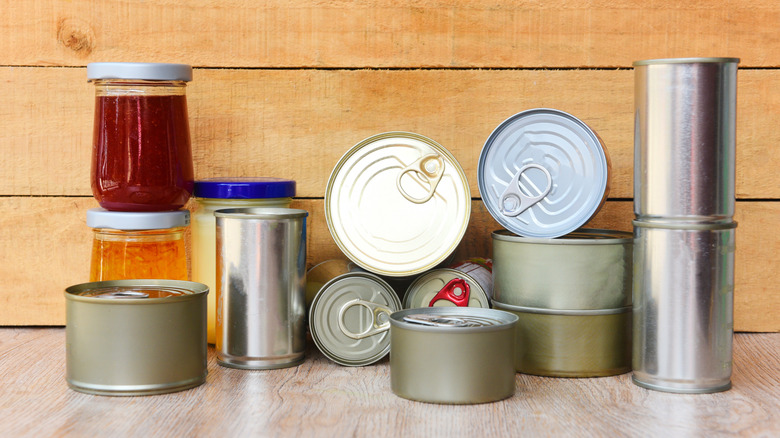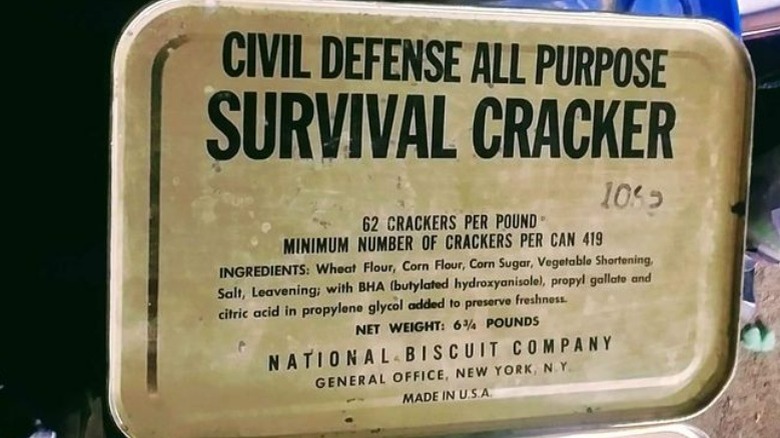The Average Pantry Of A 1950s-Era Bomb Shelter
It's a warm summer day in Pleasantville, USA, in 1955. The sun's shining, and the birds are singing. Mr. Smith is trimming the hedges around his driveway, Mrs. Landry is hanging up dresses on the clothesline, and Mr. and Mrs. Cooper are drinking lemonade out on the veranda. Teenager Donny polishes the chrome on his new Chevy Bel-Air, while little Judy plays with the neighbor girl's new puppies. As all of Pleasantville enjoys a day of merriment in this little slice of suburban heaven, they cannot possibly know that as we speak, a 62-kiloton atomic warhead gracefully soars over the Bering Strait right toward their backyards, ready to turn the good people of Pleasantville into an unobservable state of matter.
Beneath the advent of rock-and-roll and malt shops, the scenario you just read was a very real fear in 1950s America. The so-called Atomic Age, PBS tells us, was one of deep-seated anxiety as the advent of nuclear weapons made a third World War a possible and grim reality. As fears of a looming nuclear war between America and the Soviet Union gripped the country, Americans found themselves learning to "duck-and-cover" (a popular protection method via HISTORY) and building bomb shelters in their backyards. The United States government, at the time, did its best to instruct the nation on how to survive in these underground bunkers, even going so far as to list what types of food would be most appropriate for stockpiling.
The government recommended stocking Grandma's Pantry
As Eater explains, the threat of nuclear war was no joke, with Americans of all ages finding themselves preparing for if and when a nuclear attack would happen. Following the outcome of a nuclear attack, essential services such as electricity and running water would be unavailable for an unknown amount of time. To ensure that all Americans would at least have necessities during an everyman-for-himself period, the government recommended what it referred to as "Grandma's Pantry."
The cozily named campaign was the brainchild of Eisenhower's Federal Civil Defense Administration in 1955. Just as Grandma had plenty of food in her kitchen to serve anyone from family to unexpected guests, the campaign explained your fallout shelter should have at least one week's worth of food and water while waiting for help to arrive.
HISTORY tells us that the pantry was mainly a collection of non-perishable, powdered, or dried foods, such as Campbell's Soup, Hawaiian Punch drink mixes, cereals, candy bars, and other various canned goods and snacks. This assortment of comfort foods would not only be relatively long-lasting but may have been able to help keep the spirits of the shelter's occupants high while they waited for rescue.
But the U.S. government had one more superfood specifically meant for long-term survival.
The United States government invented survival crackers
While a sufficient supply of canned goods and water may have been more than enough for a family of four, it certainly wasn't enough for every American family. The U.S. government needed a food source that was cheap, easy to mass-produce, and could last for a long time without spoiling. The answer came in the form of what is known as survival crackers.
According to Baltimore History, survival crackers were produced sometime around 1958, when the U.S. Departments of Agriculture, Health, Education, and Welfare collaborated on developing a new type of survival food. Bulgur, a type of dried wheat used for many centuries throughout many civilizations, was the main ingredient in this new long-lasting food, thanks to bulgur's high resistance to contamination or infection.
The Civil Defense Museum tells us that once these survival crackers could be produced, they would be shipped across the country in food supply packages and distributed in the event of a nuclear attack. These crackers and biscuits would meet two goals: to last throughout the two weeks, the occupants had to remain in the bunker and provide enough calories (alongside the other items included in the supply packages) to ensure each person sheltered would be well-fed and avoid malnutrition.
Although the U.S. fortunately never had to distribute survival crackers to starving nuclear refugees, they can still be part of an emergency food kit.


